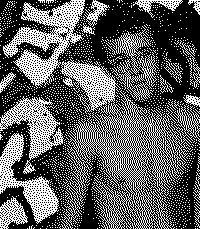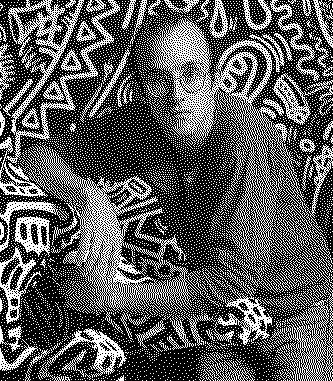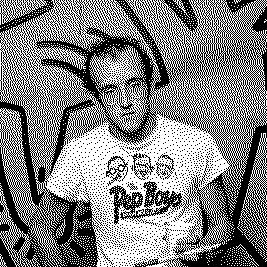Artists/Keith Haring
Fast Facts
Iconic Visual Language
Haring is known for his bold lines, vivid colors, and active figures. He developed a unique visual language, consisting of simple shapes like barking dogs, flying saucers, and dancing figures.
Subway Drawings
He gained public attention with his subway drawings, where he would draw with white chalk on the black paper used to cover unused advertising panels in subway stations.
Activism and Advocacy
Haring's work often carried social messages. He was openly gay and an advocate for safe sex; much of his later work brought attention to AIDS awareness and LGBTQ+ rights.
Pop Shop
In 1986, Haring opened the Pop Shop in New York City, where he sold merchandise bearing his iconic images. The shop made his art accessible to a wider audience.
Public Art and Murals
He created numerous public works, including the famous "Crack is Wack" mural in New York and an extensive mural for the Necker Children's Hospital in Paris.
Early Death
Haring's career was brief but intense; he died of AIDS-related complications on February 16, 1990, at the age of 31.
Biography



Keith Haring was born on May 4, 1958, in Reading, Pennsylvania, and grew up in nearby Kutztown. From an early age, Haring was deeply interested in art, a passion he inherited from his father, an amateur cartoonist. This early exposure to cartooning, combined with influences from popular culture like Disney, Dr. Seuss, and Looney Tunes, laid the foundation for what would become a vibrant and iconoclastic career in the arts.
Despite his later fame, Haring's upbringing was marked by a strong religious background, participating in the evangelical "Jesus Movement" during his teenage years. After high school, he initially pursued commercial art at the Ivy School of Professional Art in Pittsburgh but soon realized that his true calling lay beyond the confines of commercial work. Influenced by Robert Henri's "The Art Spirit," Haring decided to drop out and move to New York City in 1978, where he enrolled at the School of Visual Arts (SVA) (Wikipedia) (The Art Story).
Haring's early work was characterized by his experimentation in the New York City subway system, where he would create chalk drawings on unused advertising spaces. These early works were pivotal, not just in developing Haring's signature style of bold, animated imagery, but also in establishing his presence in the city's art scene. The subway became his "laboratory," a public space where Haring could interact with a broad audience outside the traditional confines of the art world. His work during this period was marked by the use of symbols, such as the "Radiant Baby," which became his signature. Haring's ability to communicate complex themes through simple, accessible imagery quickly earned him public recognition and acclaim (Wikipedia).
By the mid-1980s, Haring had achieved considerable fame. He was known for his vibrant, animated figures and symbols that carried social, political, and personal meanings. His work was not just confined to galleries and museums; he actively sought to make art accessible to the wider public through murals, public art projects, and his Pop Shop, which sold his artwork and merchandise. Haring's art was often political, advocating against apartheid, promoting safe sex, and raising awareness of AIDS, a cause particularly close to him as an openly gay man during the height of the AIDS crisis. His activism extended beyond his art; he was involved in various social and political causes throughout his career. Haring's work on public murals and projects around the world, including the famous "Crack is Wack" mural in Harlem, showcased his commitment to using art as a tool for social change and activism (Wikipedia) (The Art Story).
Tragically, Keith Haring's life and career were cut short when he died of AIDS-related complications on February 16, 1990, at the age of 31. Despite his brief career, Haring left an indelible mark on the world of art and culture. His legacy lives on through his vibrant works, which continue to inspire and resonate with new generations. Haring's art remains celebrated for its vibrant energy, its accessible and inclusive approach to art-making, and its unyielding commitment to social activism. In recognition of his contributions to art and society, Haring has been posthumously honored with inclusion in the Rainbow Honor Walk in San Francisco and the National LGBTQ Wall of Honor at the Stonewall National Monument in New York City (Wikipedia).
Bodies of Work
-

Subway Drawings
1980–1985
-

Nine Drawings
1981
-

Body Painting
1981
-

Ink on Vellum drawings
1981
-

Headboard
1982
-

Encaustic on Wood
1983–1984
-

The Marriage of Heaven and Hell
1984
-

Tarps
1981–1984
-

Sumi Ink Drawings
-

The Ten Commandments
1985
-

Andy Mouse (4 Variations)
1985
-

Tondos
1985
-

Pop Shop Drawings
1986
-

Apocalypse
1988
-

Collaborations with LA II (Angel Ortiz)
-

Totems
-

Masks
1987
-

Untitled Ink on Japanese Board
-

20 Drawings
1989
-

28 Heads
1989
-

Untitled (gouache and black ink on paper)
1989
-

Untitled (For James Ensor)
1989
-

Sarcophagus (in collaboration with LA II)
1983
Murals
-

Monte Carlo Mural
1989
-

Todos Juntos Podemos Parar el SIDA (Together We Can Stop AIDS)
1989
-

Tuttomondo, Pisa Italy
-

Houston Street & the Bowery
1982
-

Berlin
1986
-

Crack is Wack
1986
-

Museum of Contemporary Art in Antwerp Belgium Cafeteria
1987
-

Paris
1987
-

Carmine Street
1987
-

Boys Club
1987
-

Untitled (Great Park)
1989
-

Vehicles
Importance
Keith Haring's impact on the art world and society at large is profound and multi-dimensional, making him a seminal figure in contemporary art for several key reasons:
Innovator of Street and Subway Art
Haring's legacy begins with his innovative use of the New York City subway as a canvas for his art, drawing with white chalk on unused advertising panels. This not only made art accessible to a broader audience but also aligned him with the burgeoning underground graffiti and street art movement of the time. Despite legal challenges, including arrests for vandalism, Haring's subway art became a cultural phenomenon, bridging the gap between the underground scene and the mainstream art world.
Mainstream and International Success
Haring's art transcended the boundaries of the underground scene, achieving mainstream success. He was featured in major international art events like Documenta in Germany and the São Paulo Biennale in Brazil. His ability to travel the world and create public art in various countries further solidified his status as a global artist. Haring's collaborations across different media, including set designs, stage decorations, and album covers, showcased his versatile and accessible approach to art.
Social and Political Activism
Haring used his art to raise awareness about critical social issues, including AIDS, apartheid, and drug addiction. His activism was personal and political, using his platform and iconography to engage with issues affecting marginalized communities. The establishment of the Keith Haring Foundation further exemplified his commitment to philanthropy and social advocacy.
Commercial Success and Accessibility
Opening the Pop Shop in SoHo, Haring made his work accessible to a wider audience, challenging the notion of art as an exclusive commodity. This approach drew criticism from some quarters of the art community but reflected Haring's democratic vision of art for all. The Pop Shop allowed Haring's designs to reach beyond the gallery, influencing the way art could be consumed and appreciated by the public.
Influential Friendships and Collaborations
Haring's relationships with contemporaries like Madonna, Jean-Michel Basquiat, and Andy Warhol played a significant role in his life and work. These friendships and collaborations underscored the interconnectedness of the New York art scene and highlighted Haring's influence across artistic disciplines.
Lasting Legacy
Despite his premature death, Haring's legacy endures. He remains an icon of the LGBTQ community and a pioneer in blending artistry, political activism, and charity. His style continues to influence artists and is celebrated in collaborations with major brands, ensuring his work remains relevant.
Technique
Keith Haring's approach to creating art was both innovative and accessible, marking him as a pioneering figure in the art world for several reasons:
Versatile Use of Materials and Surfaces
Haring was known for his dynamic use of various materials, including acrylics on canvas and papier-mâché for sculptures. He also famously utilized public spaces, like subway walls and handball courts, as canvases for his murals, bringing art into the daily lives of the public (The Art Story).
Iconic Visual Language
His artwork was characterized by bold lines, bright colors, and recurring motifs, such as the Radiant Baby, the Barking Dog, and figures in motion. These symbols communicated complex social and political messages through simple, yet profound imagery, making his work both accessible and impactful (Artland Magazine).
Public and Ephemeral Art
Haring's subway drawings, created with chalk on unused advertising spaces, were a hallmark of his commitment to making art accessible outside traditional galleries. These ephemeral pieces were both an act of rebellion and a democratic approach to art, engaging a broad audience in a conversation about art and society (The Art Story) (Artland Magazine).
Engagement with Social and Political Themes
Throughout his career, Haring used his art to advocate for social change, addressing issues like AIDS awareness, apartheid, and drug addiction. His work was not just visually striking but also deeply imbued with a sense of purpose and a call to action (The Art Story) (Artland Magazine).
Innovation in Art Commercialization
By opening the Pop Shop, Haring blurred the lines between fine art and commercial items, making his work more accessible to the public. Despite criticism from some quarters, this move demonstrated his belief in art as a universal language that should be available to all, not just the elite (The Art Story) (Artland Magazine).
